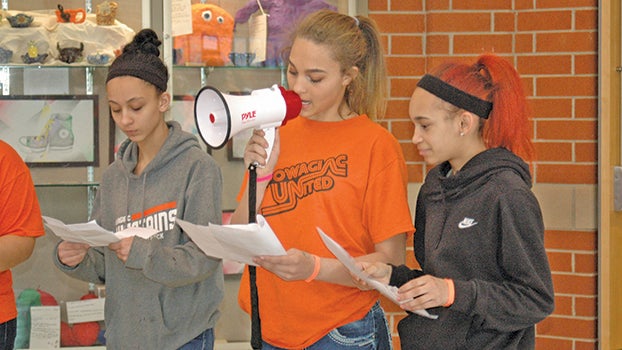Taking a Closer Look: Local students, faculty weigh in on epidemic of school violence
Published 8:53 am Monday, March 26, 2018
Twelve-year-old Dowagiac Middle School student Tori McNeil starts her day off like any child her age would. She gets up, pulls her vibrant red hair into a ponytail and gives her mother a kiss goodbye before boarding the bus to school.
When she pulls up to the school, McNeil says a quick prayer as she steps off the bus and enters the building, asking that she will live to hear the final bell of the school day.
“Half the time, I’m just happy to make it off the bus. The driver can drive crazy sometimes,” McNeil joked, tugging the sleeves of her sweatshirt over her fingers. “But, really, it can be scary to go to school, knowing how many school shootings happen. Every day after the Florida shooting, I kissed my mom and told her that I loved her, and that I’d see her after school, but I know I can’t make that promise.”
McNeil was one of four students who recently led a walkout at DMS in memory of the 17 victims of last month’s school shooting in Parkland, Florida. The walkout also served as a demonstration against gun violence in schools. The shooting in Parkland sparked not only student walkouts nationwide, but a conversation about how to keep students safe in schools, especially after the Parkland shooting was followed by a shooting at Great Mills High School in Maryland on Tuesday. It is a conversation students and school faculty are still working to come up with answers to.
To area school districts, the immediate answer is increased security.
In McNeil’s home district, Dowagiac Union Schools began installing new safety features before the Parkland shooting, planning to have camera systems in the high school and elementary schools, as well as reconfiguring each school, so that visitors to the school will need to enter an office before they can enter other parts of the school. Intercom systems will also be installed to allow better communication between rooms and heating and cooling systems will be installed to allow teachers to keep their classroom doors closed at all times.
“Student safety is our number one,” said Superintendent of Dowagiac Union Schools Paul Hartsig.
In the nearby Niles Community School District, Superintendent Dan Applegate said that students are being kept safe through similar safety procedures, including keeping exterior doors locked at all times, so that visitors must be buzzed into a school building.
Niles Community Schools have been using their lockdown drills this year to practice communication, according to Applegate. The district has also been working with local police to plan lockdown drills that will better prepare students in the event of tragedy, he said.
“When the kids know what they need to do, that can make things run smoother and help keep them safe,” Applegate said. “We also make sure our teachers and staff are very well trained. … If the kids have someone to look to that is confident and prepared if a situation occurs, I really do think that helps them.”
Both school districts are required by the state to host three lockdown drills per year at each building. Both superintendents said that they believe that the safety procedures and lockdown drills the schools have in place make students feel safe.
Hartsig said that his school district will soon be taking a “fresh look at how [it] does lockdown drills,” as part of the new renovations. He said that after every lockdown drill, he meets with law enforcement to discuss the drill and what can be done to improve.
“Law enforcement has learned from every one of these tragedies,” Hartsig said. “They talk to us about how they would like us to respond and we implement those changes. We want the best practice to keep our kids safe.”
However, both Applegate and Hartsig acknowledged that no matter how prepared the schools are, a school shooting can still happen in their district. After all, schools in the Parkland area had been practicing lockdown drills for 10 years prior to the attack last month.
“That’s one of the great tragedies of our society,” Hartsig said.
Research is unclear about how much these precautions, particularly lockdown drills, actually do to promote student safety. Some experts are concerned that lockdown drills, particularly active-shooter drills, can cause more harm than good, as they can frighten students and distract from the learning environment of the school, according to a report published by Education Week in late 2017. However, a White House document from 2013 contained a list of recommendations, including lockdown drills, to help curb gun violence in schools. Ultimately, there has been too little research on the topic to make a definitive statement about the effectiveness of the security measures that are currently in place in schools.
Students are also unclear about what their school districts should do to keep them safe.
McNeil said that her mother wanted to pull her out of public school in the wake of the Parkland shooting, but McNeil did not want that. Nonetheless, McNeil also does not want to feel unsafe in school.
She said that lockdown drills do not make her feel safe, though she admitted that preparedness might be able to save lives. McNeil suggested that perhaps metal detectors at the entrance of every school could help her to feel more secure in her school environment.
One thing McNeil said she is sure about is that something has to change. McNeil believes, as do the other three students who organized the walkout last week at DMS, that stricter gun regulations, such as more stringent background checks on gun sales and age restrictions, could be the most permanent solution to preventing gun violence in schools. At the walkout, she and her co-organizers encouraged students to write letters to Michigan legislators, asking them to consider adopting stricter gun legislation.
“We don’t want to be sitting around wondering if we could be next,” McNeil said. “People say that we are too young or that we don’t understand. … [I say] prove them wrong. We are old enough to have opinions on this.”
Though neither school faculty, students nor research may have a perfect solution to dealing with gun violence in schools, all share the same goal: keeping students safe.
Hartsig said that he will continue to devote time and energy to students’ safety and will follow the advice of law enforcement and research to find the best practice of preparing and protecting students from violence.
“Parents trust us with their kids for one-third of the day. It is our job to keep them safe,” Hartsig said. “That is something we take seriously.”
Niles High School, area administrators to host public forum on crisis preparedness
NILES — The Niles Community Schools District will host a public forum on crisis preparedness at 6 p.m. Wednesday, at Niles High School located at 1441 Eagle St.
The event, titled “Partners in Safety: A Community Town hall,” is open to the public. Niles Community Schools District Superintendent Dan Applegate invited the community to come and share their thoughts, suggestions and concerns in regards to crisis preparedness and students’ safety at school.
“I am pleased to see the continued partnership of area school districts, law enforcement and community members on issues like this one, and I hope this conversation serves as just the beginning of an ongoing discussion about our shared work to prevent and prepare for crises in our community,” Applegate said.
The event was sparked by the school shooting in Parkland, Florida and the Niles district’s subsequent review of safety procedure. Earlier this month, school administrators met with law enforcement to talk about their preparedness for crisis.
Officers from the Niles Police Department will be in attendance, alongside representative from Brandywine and Buchanan school districts.
Applegate said parents were notified of the event via mail. The district also posted the information on their Facebook page.
For more information, contact the Niles Community Schools administration office at (269) 357-7391.







